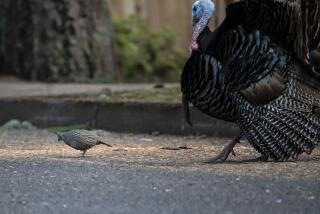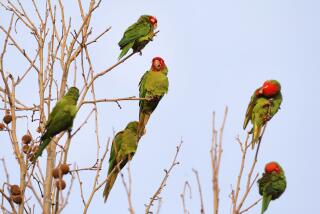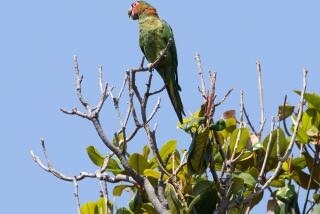‘Peacock Alley’ : Beautiful Birds Can Be Beastly Nuisance Too
On a morning a few weeks ago after a particularly fierce windstorm, Frank Langstroth was raking up the leaves and branches that littered the front yard of his house on Harter Lane in La Canada Flintridge.
Langstroth, who was muttering to himself about the damage the wind had caused, paused from his task and bent down to pick something out of the pile of debris he had gathered in one corner of his yard.
“Look, here’s a little feather,” Langstroth said, looking at a soft brown, downy feather with a brilliant flame of blue coloring at its tip.
Langstroth explained that it was from one of the wild peacocks that often parade up and down Harter Lane.
For nearly 18 years, peacocks have lived along a few secluded streets in a neighborhood just north of Angeles Crest Highway near Gould Canyon, high up on a ridge that borders the Angeles National Forest. Besides the people who live in or visit the area, few are aware that the birds inhabit the neighborhood.
Forage for Food
“I didn’t even know peacocks were up here until I moved here,” said Langstroth, who has lived on Harter Lane for 12 years.
Troops of peacocks and peahens often descend upon the neighborhood from their nocturnal roosts in the nearby deodar and eucalyptus trees to forage for food. But that morning, none of the colorful birds had appeared on a street residents have come to call “Peacock Alley.”
“With all that wind last night, I don’t know what they did,” said Langstroth, who suspected Mother Nature of some sort of fowl play. “They must have been blowing out of the trees.”
Langstroth tagged his remark with a slight chuckle, but his concern for the birds was genuine. As it turned out, the peacocks did show up later in the day, seemingly out of nowhere, to scratch and poke around in the well-kept yards along the street.
Like many of his neighbors, Langstroth has developed ambivalent feelings about the exotic birds, which, according to an old Indian saying, have “angel’s feathers, a devil’s voice and a thief’s walk.”
Many people admire the birds for their grace and beauty. But even some who appreciate the peacocks for the aesthetic quality they bring to their neighborhoods are beginning to complain that they can’t grow gardens because the peacocks eat almost everything in sight.
“We have a love-hate relationship with them because they are really beautiful and unusual to have around,” said Mary Marshall, who lives near Langstroth on Pizzo Ranch Road. “But they also eat all of our plants. I think some people even poison them and shoot at them because they get so frustrated. I’ve heard shots and thought, ‘Oh-oh, somebody finally got mad at the peacocks.’ ”
Marshall is one of a small number of residents who have gone so far as to register their complaints with the city. But, according to Bill Campbell, assistant city manager of La Canada Flintridge, there’s not much the city can do except to tell them to call the animal shelter.
Marshall said the problem is particularly frustrating for her husband, Mike, who is supervisor of grounds for Descanso Gardens and would like to have a flower garden at home. “I’ve tried to think of what could be done without killing the peacocks,” she said. “ I really don’t have an answer.”
Marshall said she even tried spraying her plants with a concoction she brewed from cigarettes. “That’s supposed to keep anything away, but it didn’t work with the peacocks,” she said.
And, when the birds are mating and have more than food on their minds, they are known to let loose their “devil’s voice,” a high-pitched, shrill love call that echoes up and down the streets at all hours.
“It’s very raucous,” said Margaret Brust, who lives across the street from Langstroth. “It’s not in keeping with their looks at all.”
Residents estimate the size of the flock at 40 to 100 peafowl, which is the term for referring to the male and female birds collectively.
The size of the flock has been kept in check by coyotes from the nearby hills. But, in recent years, the birds have turned to foraging for food in the nearby neighborhoods rather than in the wild, where they would be easy prey for the coyotes.
With a steady supply of food provided by animal lovers, the size of the La Canada flock has been steadily increasing, residents of Peacock Alley and its environs say.
Longtime city resident Frank W. Doherty said the peacocks owe their existence to his father, Frank P. Doherty, who “liked everything that was wild” and began breeding the birds in the 1930s.
Native to India
Peacocks are not indigenous to the United States and those that have been bred here are descendants of birds brought from India, their native land.
In 1936, Frank P. Doherty bought a large estate that included the area where the birds now roam. Along with the land came three peacocks that were the semi-trained pets of the property’s former owner.
Not long after buying the land, Doherty said, his father bought six peahens from the Los Angeles State and County Arboretum and “pretty soon we had peacocks all over the place. We used to put out about 100 pounds of bird seed every night.”
Doherty said that eventually about 60 peacocks were running loose on the property and were “noisy, dirty and beautiful all at once.” When the elder Doherty sold his estate to a housing developer in the late 1960s, he arranged to donate the wild peacocks to the Los Angeles Zoo.
About a dozen birds had been trapped in a makeshift pen, the son recalled, but “before we could do anything, they all got away.”
Rare in Southland
“My father said the heck with it and just left them,” Doherty said. “It was too much trouble to try and catch them.” Now, the flock of wild peacocks in La Canada Flintridge is one of only a few in the Southland, according to wildlife experts.
The largest flock of peacocks in the Los Angeles area inhabits the Palos Verdes Peninsula, said Dr. W. Joel Pasco, a veterinarian and president of the Orange County-based Alliance for Wildlife Rehabilitation and Education.
Pasco said estimates of the Palos Verdes peacock population range from 200 to 1,000 birds, based on information provided by residents of that area.
In the past few years, the birds have provoked a heated public squabble among the citizens of Palos Verdes Estates, who are bitterly divided into pro-peacock and anti-peacock factions.
About 200 peacocks live in captivity on the grounds of the Los Angeles State and County Arboretum in Arcadia. There are smaller flocks in Mission Viejo and Anaheim Hills, Pasco said.
The colorful birds are especially beautiful during the spring mating season, when males strut their stuff for the benefit of females, fanning out their long train of “angel’s feathers” in a spectacular display of iridescent blue, green and brown feathers.
“When it’s nice and sunny and a peacock is out in back with his feathers all spread out, there’s nothing more beautiful. If you’ve seen the NBC peacock, it’s just like that--only prettier,” said Lou Pizzo, whose house on Pizzo Ranch Road is a hangout for about 18 birds.
Opinions Vary
Pizzo said his daughter, Lauri, is so taken by the peacocks that she feeds them every day. His family has even taken a personal interest in nursing back to health a young peahen that broke her left leg twice in the past three months. While it recuperates, the peahen, nicknamed “Little Bean,” is being kept in an enclosure in the Pizzos’ backyard.
A neighbor does not share their love for the birds, Pizzo said, and has trained his dogs to chase the peacocks from his yard. Pizzo admitted that he, too, gets tired of cleaning up after the birds. “What would be ideal,” he said, “would be to have them in your neighbor’s yard and have him clean up the dirt and you could look at them.”
And, unlike the NBC peacock, real peacocks can be heard as well as seen. Residents compared their love calls to anything from a baby calling for help to someone yelling “play ball, play ball” to the screams in an insane asylum.
Rosemary Martinelli recalled that when she and her husband first heard the peacocks after moving to their home on Vista Lejana Lane four years ago they used to sit straight up in bed. “It scared us to death.” she said. But now, Martinelli said, her family has grown used to hearing the love call and hardly notices it.
Residents say they also have gotten used to the sound of peacocks walking on their rooftops, where the birds have a propensity to perch during the daytime.
Betty Hetherington said she’s had as many as 10 peacocks trooping across the roof of her house on Harter Lane. “They sound like they have big boots on,” she said.
The peacocks also seem to love hoods of cars. Brust said nothing used to make her husband angrier than the sight of peacocks scratching around and leaving their droppings on the hood of the family car.
“One thing about it, though,” Brust said with a laugh, “I could always find my car in a parking lot. Mine was the decorated one.”
In spite of the mess, the noise and the damage the peacocks do to their gardens, many who share their neighborhoods with the birds say they would miss them if they weren’t around. Some favor reducing their numbers, but only if it can be done by humane means.
“It may be nice to cut back on the number,” said Langstroth, “but not to get rid of them. I enjoy them. I have to take care of the yard and it does annoy me, but the wind does more damage than the peacocks.”
More to Read
Sign up for Essential California
The most important California stories and recommendations in your inbox every morning.
You may occasionally receive promotional content from the Los Angeles Times.








